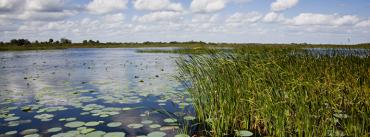
Expect water to be the most dominant item on the Florida Legislature's 2017 agenda. And for that reason, the 7th Annual Florida Water Forum beginning at 1 p.m. today at Loew's Royal Pacific Hotel and Resort in Orlando has already captured the attention of business leaders, lawmakers, scientists and environmentalists -- people looking to solve the critical water issues Florida faces right now.
"Our business climate, our ability to grow as a state, and our quality of life are all directly tied to the availability and sustainability of our water resources," says sponsor Associated Industries of Florida. AIF, representing 10,000 employers in Florida, has a long history of engagement in water issues.
With the passage of the 2016 Water Bill (SB 0552) and the influx of money from the Water and Land Conservation Amendment, Florida is devoting the time, money, and attention to water that it has not done in many years, AIF points out.
Here are some of the issues the forum likely will take up:
- Time is of the essence: Some of Florida's largest economic regions face significant challenges as affordable, sustainable groundwater runs out in the not-too-distant future.
- Water shortages also bring about associated acrimonious and expensive litigation among water users, challenges to water management district permits, restrictions on new economic development, and in some areas a continued decline in natural resources.
- Southeast Florida must still balance water supply with environmental needs, both heavily dependent on Lake Okeechobee, and face saltwater intrusion concerns.
- Southwest Florida remains "wrapped in a water-use caution area" and is also vulnerable to saltwater seeping into the aquifer.
- Central Florida is still planning for a long-term groundwater shortage.
- North Florida continues to see controversy and concern stemming from its abundant springs.
- Innovative solutions and expanded infrastructure hold a great deal of promise. Does Florida embrace these possibilities, or slide further toward problems like those in California?
Some of Florida’s top technical experts, policymakers and elected leaders are taking part. This is the agenda for the event:
Thursday
1:10 p.m. Opening Comments by Herschel Vinyard, Foley & Lardner LLC
1:30 p.m. Florida’s Water Quality Challenges Panel. Moderator: Herschel Vinyard, Foley & Lardner LLC; Panelists: Drew Bartlett, Florida Department of Environmental Protection;
Rich Budell, Florida Agribusiness Council; Brian Lapointe, Florida Atlantic University
2:15 p.m. Reclaimed Water Panel. Moderator: Sen. Kelli Stargel, R-Lakeland; Panelists: Ernie Barnett, Water and Land Advisors, Inc.; Ryan Matthews, Florida Department of Environmental Protection - Office of Water Policy; Brian Armstrong, Southwest Florida Water Management District; Lisa Wilson-Davis, Florida Water Environment Association Utility Council
3:30 p.m. The Energy/Water Nexus Panel. Moderator: Commissioner Jimmy Patronis, Florida Public Service Commission; Panelists: Chip Merriam, Orlando Utilities Commission; Paul Steinbrecher, JEA
4:20 p.m. Regional Break-Out Session
North Florida. Moderator: Rep. Halsey Beshears, R-Monticello; Panelists: Mike Markey, Gulf Power; Noah Valenstein, Suwannee River Water Management District; Cliff Wilson, Dewberry
Central Florida. Moderator: Rep. Neil Combee, R-Auburndale; Panelists: Ann Shortelle, St. Johns River Water Management District; Brian Wheeler, Toho Water Authority; Laura Donaldson, Manson Bolves Donaldson Varn
South Florida. Moderator: Rep. Ben Albritton, R-Bartow; Panelists: Jeff Sumner, Federico & Associates, Inc.; Rich Budell, Florida Agribusiness Council; Greg Knecht, The Nature Conservancy; Len Lindahl, South Florida Water Management District
Friday
After breakfast an awards presentation will honor House Speaker Steve Crisafulli, R-Merritt Island.
8:40 a.m. 2017 Water and Environmental Appropriations Preview. Sen. Jack Latvala, R-Clearwater
9:10 a.m. Amendment 1 Panel. Moderator: Rep. Jim Boyd, R-Bradenton; Panelists: Gary Clark, Florida Department of Environmental Protection; Greg Munson, Gunster; Temperince Morgan, The Nature Conservancy; Frank Bernardino, Anfield Consulting
10 a.m. Constitutional Revision Commission with Frank Matthews, Hopping Green, and Sams
10:20 a.m. Emerging Issues. Stormwater Management for Enhanced Spring Shed Protection: A P3 Success Story, with Kent Koptiuch, Nestle Waters; Is Florida Ready for Direct Potable Reuse? with Chuck Drake, Tetra Tech
11 a.m. Closing Remarks by Brewster Bevis, AIF senior VP-state and federal affairs.
Reach Nancy Smith at nsmith@sunshinestatenews.com or at 228-282-2423. Twitter: @NancyLBSmith


